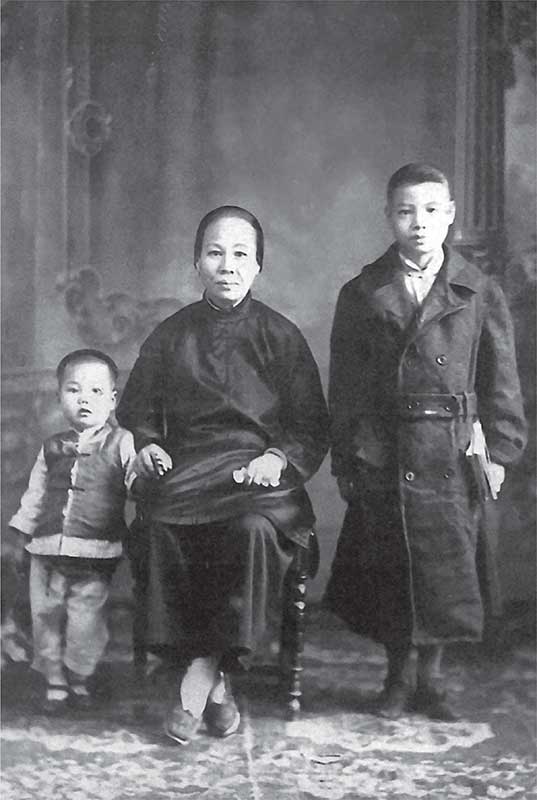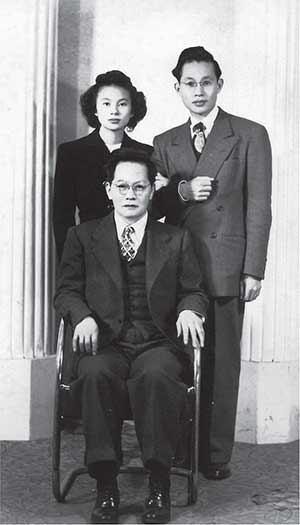
Judy Wing Lee’s family in China. Her uncle and her father (left) followed her grandfather to Ohio. Her grandmother remained behind. Courtesy of Judy Wing Lee.
INTRODUCTION
From the mid-nineteenth century until the latter stages of World War II, the forbearers of those who would grow up in San Francisco’s Chinatown as baby boomers sailed for what they hoped would be fairer shores. They abandoned underdeveloped villages in southern China that perpetually experienced famine, natural disaster, incompetent or corrupt governance and war. They embarked on arduous voyages for a land governed by immigration laws specifically directed against the Chinese. As women and children were strictly forbidden from entry, married men abandoned their families, and bachelors expected to remain single. Still, they called their ultimate destination Gum San, the “Golden Mountain.” Despite the optimistic nature of that name, the men from China’s Toishan district were not so naive as to think that their first steps ashore would yield immediate wealth or the end of hardship. Despite their small physical stature, they came fortified with outsized resolve and determination. They were prepared to endure continued and even greater hardships than those they had known at home. They aspired to replace suffering that never yielded rewards with struggles that could at least provide hope. Their own lot might not improve, but they were prepared to give their all for those left behind or for whoever might come in the future.
The stories in this book look back to the days of its contributors’ childhood and adolescence. It was a time when parents and grandparents held them close to the culture and heritage of old China. The youngsters, however, also felt the strong pull of a future sheathed in the red, white and blue of America.

Judy Wing Lee’s family in China. Her uncle and her father (left) followed her grandfather to Ohio. Her grandmother remained behind. Courtesy of Judy Wing Lee.

The author’s paternal grandfather poses with his parents on their wedding day in San Francisco, 1947. Author’s collection.
Many of San Francisco’s American-born Chinese (ABCs) of the baby boomer era lived within the confines of the twenty-nine-square-block section of the city that was Chinatown. The neighborhood, characterized as a city within a city, provided its residents with everything they could need or want: homes, shops, schools, restaurants, entertainment venues, medical services and employment. Centrally located Chinese Hospital is where many of the ABCs were born. Their grandparents and parents who had settled in Chinatown upon first arriving from China had originally been denied access to the rest of the city. The immediate postwar years saw the city become a bit more welcoming to its Chinese citizens, and Chinatown began to grow and push its way toward North Beach and Telegraph Hill.
All of Chinatown—from its many, many alleys to the block-long sprawl of any of its four Ping Yuen housing complexes—was an extension of the ABCs’ individual homes. They knew every nook and cranny, and they knew most of the people in the streets, the shops or residential buildings. If the American-born generation did not know them, the Chinatown old-timers certainly knew the youngsters. The elders also knew their parents. More often than not, they knew the kids’ entire extended family. They kept an eye on the kids wherever they went and whatever they did. They guided, chided and kept them safe. So long as they behaved and were respectful of others, they could go anywhere and do anything from early in the morning until late at night.
Through their memories, these ABCs show readers how they spoke two languages, bought into two nationalities and reaped the benefits of two rich and vibrant cultures. Sometimes the two cultures were so blended that they could not distinguish one from the other. Some residents continue to grapple with the matter of identity—Chinese, American or both? One former Chinatown kid remembers enjoying foo-yue sandwiches as much as he did peanut-butter ones. Foo-yue is a Chinese condiment made from salted and fermented bean cake. Like peanut butter, it comes in jars and can be easily scooped out and spread on a slice of bread. The liquid medium in which foo-yue sits offers a bit more than peanut butter does, however—it could provide a hint of an alcoholic buzz or could make you sick.
This book’s anecdotes will take readers deep into Chinatown to illustrate how the ABCs and their parents shared the neighborhood and their lives with tourists. They served them in shops and restaurants. They gave them directions to all the “must see” spots in the city. They answered questions about themselves or about China. What they sometimes told the visitors was a blend of truth and fiction. They inherently knew that “I don’t know” in their very own part of the city where they earned their livelihood through the tourist trade was not good for business. After the day’s last visitor had left, the people of Chinatown could return to their own lives at home.
The ABCs beckon readers into their homes. For many, it was a small living space in back of or on the floor above a family business. Chinatown’s housing, then as now, included small and cramped apartments or flats. Some residents lived in one of the four high-demand housing projects on Pacific Avenue, the Ping Yuen (“Peace Gardens”). Others shared a single room with a communal kitchen and bathrooms down the hall with far too many neighbors. Their laundry, hung to dry from rooftops, balconies and fire escapes, provided a little color to dank buildings crowded against one another in narrow alleys. There were often multiple generations of relatives living with the young ABCs. Knowing nothing different, few were unhappy about their living conditions. Few realized that Chinatown was in reality a ghetto.
Readers walk beside adult ABCs as they once more stroll down well-worn streets, such as Grant Avenue, Stockton Street, Clay Street, Jackson Street, Beckett Alley and Waverly Place. They stop at their old markets, movie houses, late-night snack, or siu-yeh, joints and the gai-chongs, where so many of their mothers labored as low-wage garment workers. They walk by the old shops and businesses where they worked for their families, the playgrounds where they so quickly adapted to all-American games and the various Chinese schools they were usually loath to attend.
All of the one-time Chinatown kids who have contributed to this tour of remembrances hope that all who would join them will see and know the deepest corners of San Francisco Chinatown’s heart and soul as they were in its golden age.